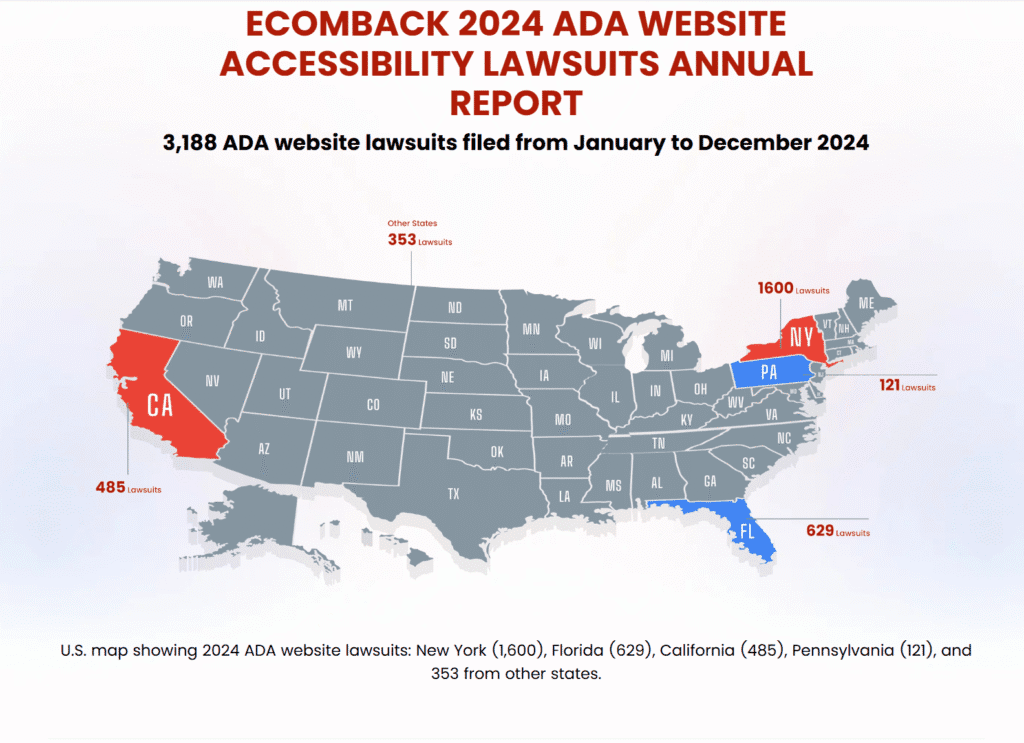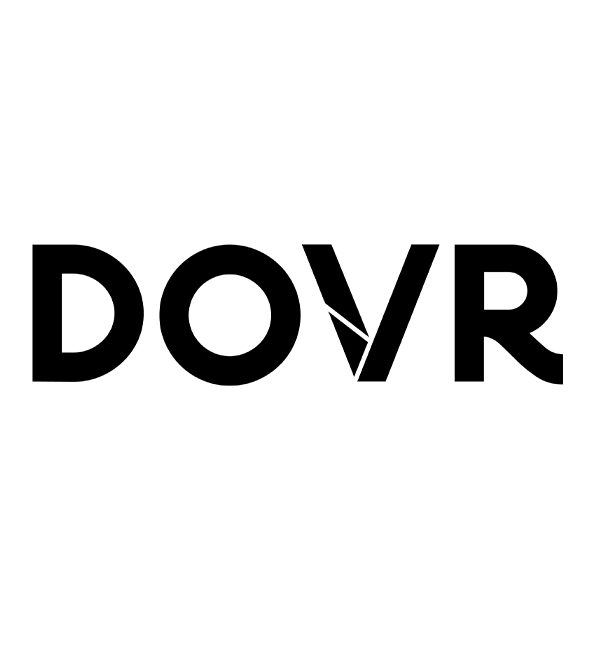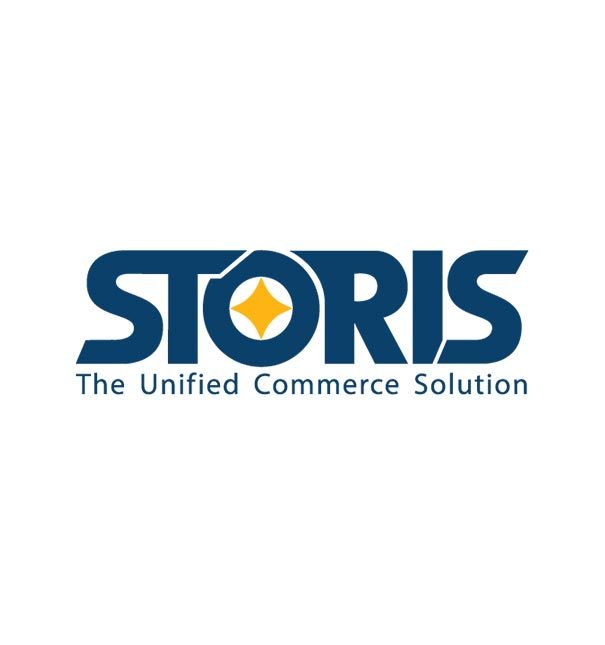What Smart Retailers Are Doing About It
Consumers across the country are suing retailers over ADA website accessibility. Avoid becoming the next target. Here’s a practical overview: why ADA compliance matters, how the law is being used against retailers, and immediate steps you can take to stay compliant and reduce your business’s litigation risk.
Why retailers can’t ignore ADA web accessibility anymore
The Americans with Disabilities Act (ADA) prohibits discrimination by “places of public accommodation,” which includes retail stores and other customer-facing businesses. The U.S. Department of Justice (DOJ) has repeatedly stated that this applies not only to your physical location but also to the goods and services you offer online. At the same time, digital accessibility lawsuits have become a routine business risk, not rare events.
In 2024, over 4,000 accessibility lawsuits involving websites and apps were filed in U.S. courts, continuing several years of steady growth. Retailers and eCommerce sites in Lifestyle, Fashion, and Clothing and Apparel consistently top the list of defendants. Any retailer with an inaccessible site risks demand letters, class actions, and public settlements.

Recent lawsuits every retailer should know about
Here are a few key cases and trends that explain why web accessibility is such a hot issue.
Robles v. Domino’s Pizza (9th Circuit)
A blind customer, Guillermo Robles, was unable to order pizza through Domino’s website and mobile app using his screen reader.
The Ninth Circuit Court of Appeals held in 2019 that the ADA does apply to Domino’s digital properties because they’re “services” of a physical place of public accommodation. Domino’s eventually reached a settlement in 2022 after six years of litigation, and the case is widely viewed as a landmark in digital accessibility.
Why you should care: If your business has physical stores, as well as a website/app (like most retailers), this case strongly supports the idea that your digital experiences must be accessible.
Gil v. Winn-Dixie (11th Circuit)
A visually impaired customer, Juan Carlos Gil, sued Winn-Dixie because its website wasn’t compatible with his screen reader. The trial court initially found Winn-Dixie in violation of the ADA, but the Eleventh Circuit later reversed, holding that a website itself is not a “place of public accommodation” and that in this specific case, the site did not create a barrier to access.
Why you should care: This decision conflicts with the Domino’s ruling, highlighting the current legal uncertainty. Courts in different jurisdictions may interpret the ADA’s application to websites differently, which means businesses cannot rely on a single clear standard. This uncertainty makes it even more crucial for retailers to follow industry best practices and seek clarity through standardization.
Fashion Nova settlement
In 2025, Fashion Nova agreed to a $5.15 million class-action settlement after allegations that its website was inaccessible to blind customers relying on screen-reading software. The suit claimed that poor code and missing accessibility features prevented visually impaired shoppers from accessing core site functions, such as browsing and purchasing.
Takeaway for retailers: You don’t have to be a global giant to be targeted. Plaintiffs’ firms actively search for inaccessible retail sites, often focusing on checkout flows, promotions, and loyalty programs that are unusable with assistive technologies.
What the ADA expects online (in practice)
The ADA doesn’t list line-by-line technical web rules the way a coding standard might. Instead, it sets outcome-based obligations: businesses open to the public must provide “full and equal enjoyment” of goods and services and ensure effective communication with people with disabilities. Because of that, the DOJ has issued guidance clarifying that:
- The ADA applies to web content and online services offered by public accommodations (including retailers).
- Inaccessible websites that block or hinder people with disabilities from using services can violate the ADA.
- For state and local governments (Title II), the DOJ took a further step in 2024 by issuing a final rule that requires their websites and apps to comply with WCAG 2.1 Level AA by setting deadlines.
- Private retail websites (Title III) don’t yet have an equivalent binding rule, but:
DOJ guidance and enforcement actions often point to WCAG as the technical benchmark.
- Courts and settlement agreements frequently refer to WCAG 2.0/2.1 AA as the standard for achieving compliance.
Practical interpretation: If you run a retail site and want to lower risk, treat WCAG 2.1 AA as your baseline “playbook” for ADA web compliance.
Why there’s such a push for regulation and standardization
Right now, businesses face:
- A legal patchwork: Courts in different jurisdictions interpret ADA requirements for websites differently, leading to uncertainty about which standard applies to your business.
- No explicit Title III “web standard”: The ADA itself doesn’t name WCAG, and DOJ hasn’t finalized a website rule for private businesses.
- Aggressive enforcement and private lawsuits: Despite the lack of a specific technical rule, the DOJ and plaintiffs continue to argue, “You should have made it accessible.”
This combination creates:
- Uncertainty for retailers
- It’s difficult for businesses to determine what level of accessibility is sufficient, due to the absence of a universal legal standard and the risk that different courts may require different levels of compliance.
- Inconsistent experiences for customers with disabilities
- Without a common standard, every site does something slightly different—or nothing at all—forcing users to constantly relearn patterns or give up.
- Inefficiency for the whole ecosystem
- Designers, developers, platforms, and vendors all benefit when there’s a clear, widely adopted standard. That’s why WCAG has effectively become the global reference, and why the DOJ’s use of WCAG 2.1 AA for government sites is such a significant signal of where things are headed.
For retailers, standardization is your friend. It gives you:
- A clear target (WCAG 2.1 AA) to build into RFPs, vendor contracts, and QA processes.
- A defensible story if you’re ever challenged: “We followed recognized best practices and an internationally accepted standard.”
How retailers can keep their website ADA compliant
(Not legal advice, just practical steps you can take. Always coordinate with your legal counsel and technical team.)
Step 1: Commit to WCAG 2.1 AA as your baseline
Decide internally: “Our digital content will meet WCAG 2.1 AA.”
Use that standard to guide:
- Platform and theme selection
- Custom development and integrations
- QA checklists and content workflows
- Contracts with agencies and vendors
Step 2: Get an accessibility audit (automated + human)
- Use automated scanning tools for obvious issues (missing alt text, low contrast, empty links).
- Pair that with a manual audit by accessibility professionals, ideally including testers who use screen readers and navigate using only a keyboard.
- Prioritize fixes that block conversions, including navigation, product search, product pages, cart, checkout, account/login, promotions, and coupons.
- Lawsuit data shows that plaintiffs often target critical flows, such as buying, rewards sign-up, or accessing sales.
Step 3: Fix the common retail problem areas
Focus on issues that show up again and again in lawsuits and audits:
Images & product media
- Provide meaningful alt text for product images (e.g., “Navy upholstered sectional sofa with chaise, left-hand facing” instead of “IMG_1234”).
- Ensure Zoom tools, 360-views, and videos are keyboard accessible and labeled.
Keyboard navigation & focus
- Every feature (menus, filters, modals, size/color selectors, carousels) must be usable without a mouse.
- Ensure visible focus indicators so keyboard users can see where they are on the page.
Color and contrast
- Body text and icons should meet the WCAG contrast ratios so that shoppers with low vision can read prices, promotions, and buttons clearly.
Forms, checkout, and account flows.
- Label every form field properly (name, address, credit card, etc.).
- Provide clear error messages that are announced to screen readers and are visually obvious.
- Don’t rely solely on placeholder text for instructions.
Headings and structure
- Use proper heading levels (H1, H2, etc.) so assistive tech users can scan categories, product grids, and FAQs efficiently.
Multimedia & PDFs
- Provide captions for product videos and promotional content.
- Ensure PDFs (e.g., lookbooks, spec sheets) are tagged and accessible—or provide accessible HTML equivalents.
Step 4: Build accessibility into your content and marketing workflows
Accessibility is an ongoing process, not a one-time project.
- Train marketing, eCommerce, and content teams on the basics, such as writing alt text and using headings correctly.
- Create checklists for new campaigns, including landing pages, banners, seasonal lookbooks, loyalty sign-ups, and more.
- Make sure whoever uploads products (internal staff or vendors) understands your accessibility requirements.
Step 5: Manage third-party tools and integrations
Retail sites often rely on:
- Chat widgets
- Pop-up promos
- Review and rating platforms
- Embedded loyalty or financing widgets
- Third-party booking or delivery services
These can all introduce accessibility problems.
- Select vendors that are committed to WCAG 2.1 AA and can provide relevant documentation.
- Test key flows with assistive technologies before launch.
- Spell out accessibility responsibilities in your vendor contracts.
Step 6: Publish an accessibility statement & feedback channel
A simple accessibility statement on your site can:
- Signal that you take accessibility seriously,
- Outline what standard you’re aiming for (e.g., WCAG 2.1 AA), and
- Provide a way for customers to report problems (email, phone, form).
While it doesn’t replace compliance, it shows good faith, which can help if someone raises a concern or before a small issue becomes a formal complaint.
DOWNLOAD Website Accessibility Checklist
ADA web accessibility: risk to manage, opportunity to serve
For retailers, ADA-accessible websites are no longer just a “nice to have” or a one-off project after a redesign. They’re:
- A legal obligation increasingly enforced through lawsuits and DOJ guidance.
- A brand and customer-experience issue that directly affects whether people can browse, buy, and stay loyal to you.
- A process and culture shift: when accessibility is baked into how you design, build, and market online, you reduce risk and open your doors wider.
In retail today, an ADA-accessible website isn’t just a legal safeguard; it’s a core part of delivering a modern, inclusive shopping experience. As lawsuits continue to rise and federal guidance increasingly points toward WCAG 2.1 AA as the expected standard, retailers can no longer afford to treat accessibility as optional or “nice to have.” Ensuring your website is accessible protects your brand, expands your customer base, and positions your business as forward-thinking and customer-first. By aligning your digital presence with accessibility best practices, you’re not just reducing risk; you’re opening your doors wider and ensuring every customer has a fair and seamless path to browse, engage, and make a purchase.
*This content was compiled in collaboration with AI tools













